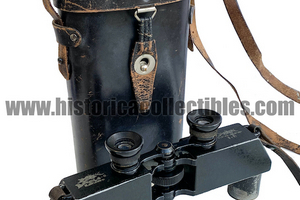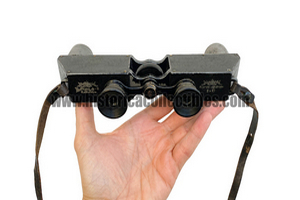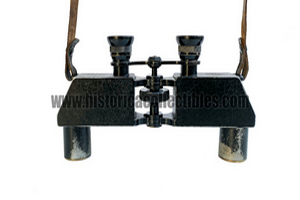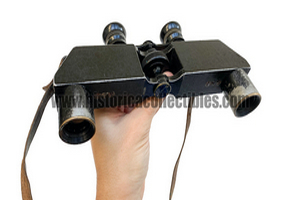Binoculars 6x21 "Stereo-Clarlux", Emil Busch AG Optische Industrie, about 1920
Binoculars 6x21 "Stereo-Clarlux" model, manufactured by Emil Busch AG Optische Industrie around 1920.
The peculiarity of this binoculars, beyond its external conformation, is to be found inside where, for its functioning, some "roof" prisms of the Sprenger-Leman type were used, (the name of the prisms comes from the names of the inventors which obtained the patent in 1895 with No. 94450).
They are two identical prisms of a very complex shape, each has 4 faces, one of which is precisely defined as a "roof" where the ray of light, contrary to what happens in the prisms invented by Ignazio Porro, crosses only two refracting surfaces.
These binoculars are very similar to the model called "Teleplast 5x" produced by Carl Zeiss, in which the same Sprenger-Leman prisms were used. The differences between the two models can be found in the focus which, on this is obtained by rotating a central screw knob and a single eyepiece, while its magnifications are 6x.
It is believed that the production of this model was extremely limited precisely due to the high cost of production following the difficulties encountered in the realization of its particular prisms. In fact, currently we have only a few other specimens in private collections.
The binoculars are in excellent cosmetic condition, fully functional with bright and sharp vision.
It comes with its original complete leather case, also in excellent condition.
History of Emil Busch:
Emil Busch was born on 6 August 1820 in Berlin and died in Rathenow on 1 April 1888 and was one of the most important German industrialists in the field of optics and precision mechanics. He was one of the proponents of the invention of the wide angle.
He was the son of the Berlin merchant Friedrich Ludwig Busch and his wife Jeanette, daughter of the entrepreneur Johann Heinrich August Duncker. In 1836 he moved with his family from Berlin to Rathenow. In 1840 Emil Busch returned to Berlin as an apprentice optician and mechanic. In 1845 he acquired the Industry Institute Optical from his uncle Edward Duncker. He equipped the factory with new machinery that he had partly built in his own mechanical workshop. The use of the new machines led to a significant increase in production data also because, thanks to the machinery, he was able to limit production times compared to manual work alone.
In 1852 he began the study and production of photographic lenses and in 1865 his first wide-angle lens "Pantoscop" was released. The founder of architectural photogrammetry Albrecht Meydenbauer exchanged views on the technical implementation of a camera which was equipped with the "Pantoscop" lens in 1867. In 1868 Busch was appointed "Königlichen Kommerzienrat" by the king for his services.
In 1872 he transformed the company into a joint stock company in order to facilitate the investments necessary for growth. This happened thanks to the help of Vereinsbank Quistorp & Co. which brought the company's share capital to $275,000. In the company since then called Rathenower Optical Istituto Industriale ex Emil Busch A.-G. Emil Busch, held the very important position of "Delegate of the Supervisory Board" and was its director.
The company achieved a dominant role in the following period. Thanks to unofficial agreements with Zeiss he limited free competition. The name Emil Busch has always been synonymous with extreme quality in the optical field.





